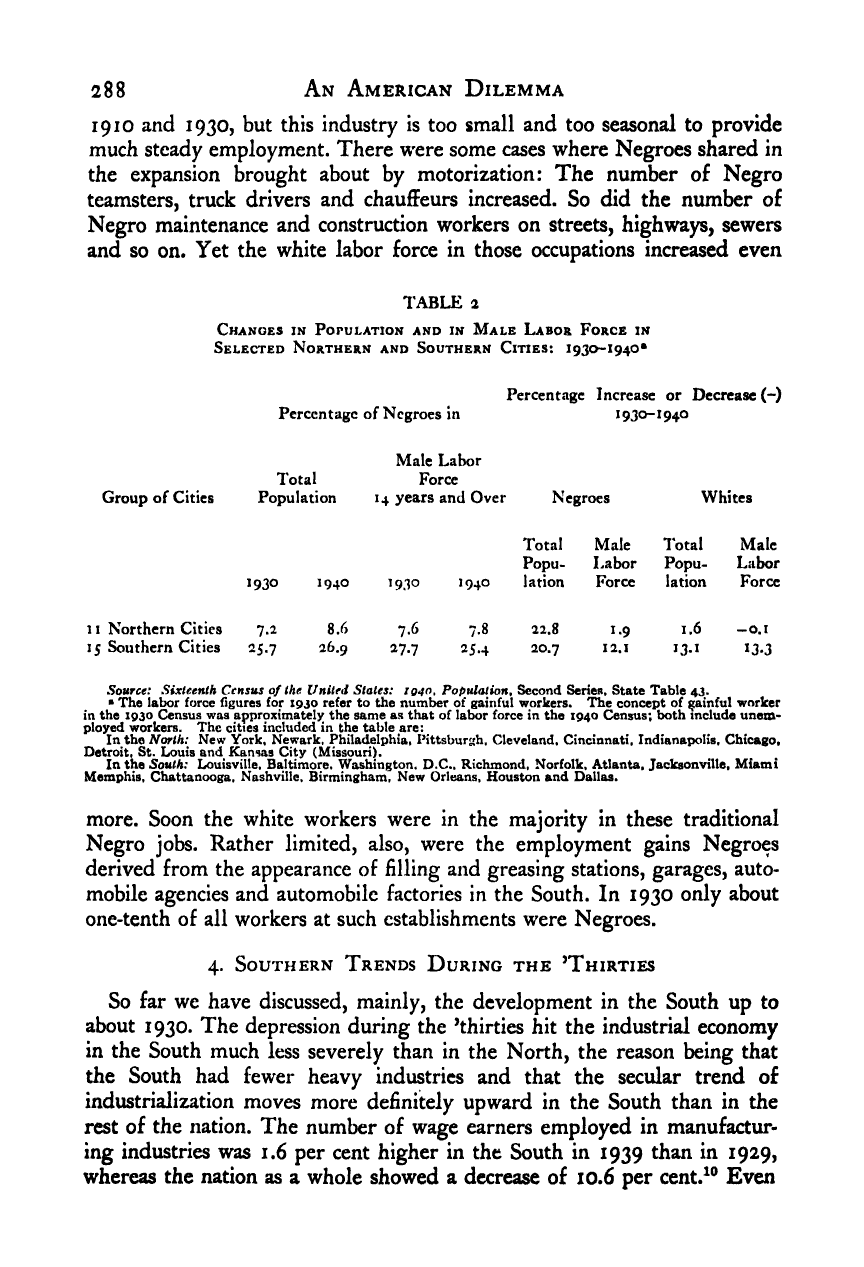Note: Gunnar Myrdal died in 1987, less than 70 years ago. Therefore, this work is protected by copyright, restricting your legal rights to reproduce it. However, you are welcome to view it on screen, as you do now. Read more about copyright.
Full resolution (TIFF) - On this page / på denna sida - IV. Economics - 13. Seeking Jobs Outside Agriculture - 3. A Closer View - 4. Southern Trends during the ’Thirties

<< prev. page << föreg. sida << >> nästa sida >> next page >>
Below is the raw OCR text
from the above scanned image.
Do you see an error? Proofread the page now!
Här nedan syns maskintolkade texten från faksimilbilden ovan.
Ser du något fel? Korrekturläs sidan nu!
This page has never been proofread. / Denna sida har aldrig korrekturlästs.
288 An American Dilemma
1910 and 1930, but this industry is too small and too seasonal to provide
much steady employment. There were some cases where Negroes shared in
the expansion brought about by motorization: The number of Negro
teamsters, truck drivers and chauffeurs increased. So did the number of
Negro maintenance and construction workers on streets, highways, sewers
and so on. Yet the white labor force in those occupations increased even
TABLE 2
Changes in Population and in Male Labor Force in
Selected Northern and Southern Cities: I930~i940*
Percent.’igc Increase or Decrease (-)
Percentage of Negroes in 1930-1940
Male Labor
Total Force
Group of Cities Population 14 years and Over Negroes Whites
Total Male Total Male
Popu- Labor Popu- Labor
1930 1940 1930 1940 lation Force lation Force
1 1 Northern Cities 7.2 8.6 7.6 7.8 22.8 U9 1.6 -O.I
15 Southern Cities 25.7 26.9 27.7 25.4 20.7 12.1 13.1 X3.3
Source: Sixteenth Census of the United States: i04o. Population, Second Series, State Table 43.
• The labor force figures for 1930 refer to the number of gainful workers. The concept of gainful worker
in the 1930 Census was approximatcljr the same as that of labor force in the 1940 Census; both include unem-
ployed workers. The cities included in the table are; ^
In the North: New York, Newark, Philadelphia, Pittsburgh, Cleveland, Cincinnati, Indianapolis, Chicago.
Detroit, St. Louis and Kansas City (Missouri).
In the South: Louisville. Baltimore. Washington, D.C,, Richmond, Norfolk, Atlanta, Jacksonville, Miami
Memphis, Chattanooga, Nashville. Birmingham. New Orleans, Houston and Dallas.
more. Soon the white workers were in the majority in these traditional
Negro jobs. Rather limited, also, were the employment gains Negroes
derived from the appearance of filling and greasing stations, garages, auto-
mobile agencies and automobile factories in the South. In 1930 only about
one-tenth of all workers at such establishments were Negroes.
4. Southern Trends During the ’Thirties
So far we have discussed, mainly, the development in the South up to
about 1930. The depression during the ’thirties hit the industrial economy
in the South much less severely than in the North, the reason being that
the South had fewer heavy industries and that the secular trend of
industrialization moves more definitely upward in the South than in the
rest of the nation. The number of wage earners employed in manufactur-
ing industries was 1.6 per cent higher in the South in 1939 than in 1929,
whereas the nation as a whole showed a decrease of 10.6 per cent.^® Even
<< prev. page << föreg. sida << >> nästa sida >> next page >>